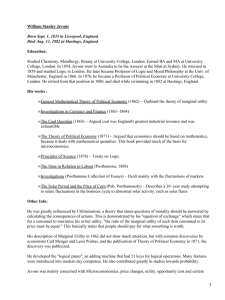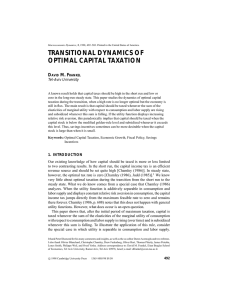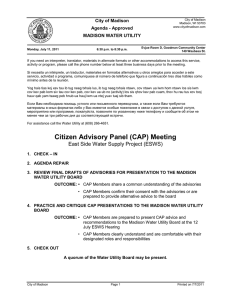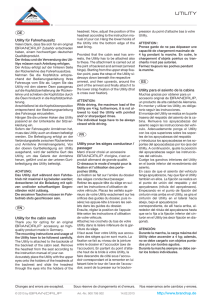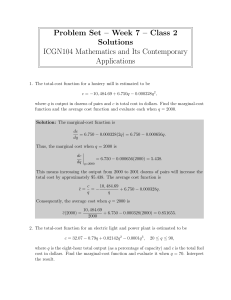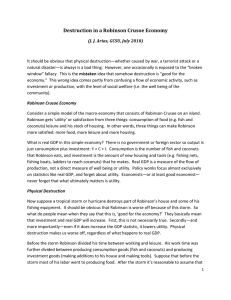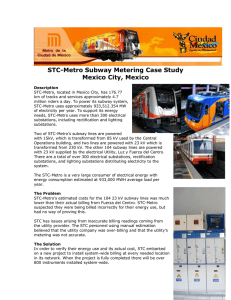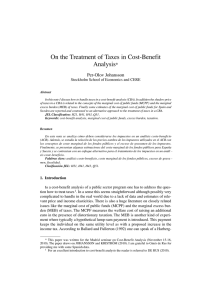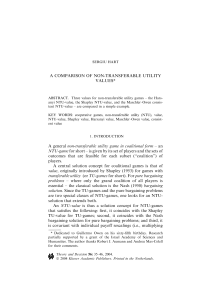Five key criticisms about the theory of marginal utility - E
Anuncio
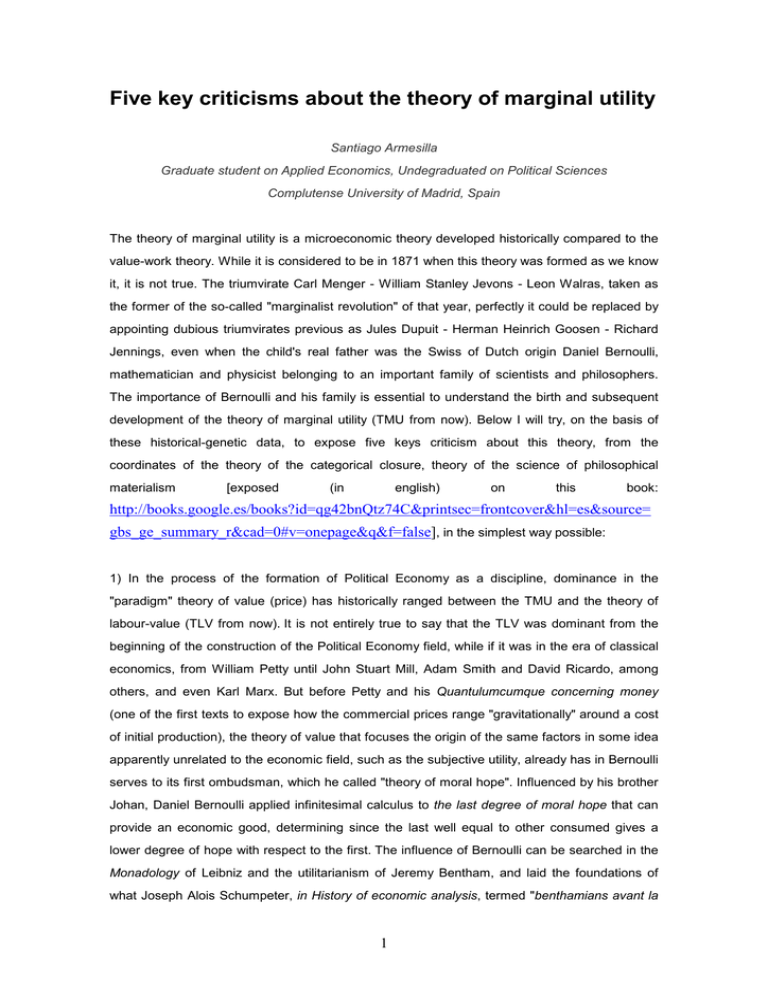
Five key criticisms about the theory of marginal utility Santiago Armesilla Graduate student on Applied Economics, Undegraduated on Political Sciences Complutense University of Madrid, Spain The theory of marginal utility is a microeconomic theory developed historically compared to the value-work theory. While it is considered to be in 1871 when this theory was formed as we know it, it is not true. The triumvirate Carl Menger - William Stanley Jevons - Leon Walras, taken as the former of the so-called "marginalist revolution" of that year, perfectly it could be replaced by appointing dubious triumvirates previous as Jules Dupuit - Herman Heinrich Goosen - Richard Jennings, even when the child's real father was the Swiss of Dutch origin Daniel Bernoulli, mathematician and physicist belonging to an important family of scientists and philosophers. The importance of Bernoulli and his family is essential to understand the birth and subsequent development of the theory of marginal utility (TMU from now). Below I will try, on the basis of these historical-genetic data, to expose five keys criticism about this theory, from the coordinates of the theory of the categorical closure, theory of the science of philosophical materialism [exposed (in english) on this book: http://books.google.es/books?id=qg42bnQtz74C&printsec=frontcover&hl=es&source= gbs_ge_summary_r&cad=0#v=onepage&q&f=false], in the simplest way possible: 1) In the process of the formation of Political Economy as a discipline, dominance in the "paradigm" theory of value (price) has historically ranged between the TMU and the theory of labour-value (TLV from now). It is not entirely true to say that the TLV was dominant from the beginning of the construction of the Political Economy field, while if it was in the era of classical economics, from William Petty until John Stuart Mill, Adam Smith and David Ricardo, among others, and even Karl Marx. But before Petty and his Quantulumcumque concerning money (one of the first texts to expose how the commercial prices range "gravitationally" around a cost of initial production), the theory of value that focuses the origin of the same factors in some idea apparently unrelated to the economic field, such as the subjective utility, already has in Bernoulli serves to its first ombudsman, which he called "theory of moral hope". Influenced by his brother Johan, Daniel Bernoulli applied infinitesimal calculus to the last degree of moral hope that can provide an economic good, determining since the last well equal to other consumed gives a lower degree of hope with respect to the first. The influence of Bernoulli can be searched in the Monadology of Leibniz and the utilitarianism of Jeremy Bentham, and laid the foundations of what Joseph Alois Schumpeter, in History of economic analysis, termed "benthamians avant la 1 lettre", the margiutilitarists. The contraction margiutilitarists describes very well both neoclassical and austrian microeconomists or even keynesians, in both would differ from the classic utilitarianism (Bentham, Stuart Mill, a philosophy that flees from the pain in search of the pleasure for the greatest number of people, linking the measures that increase the individual happiness with pleasure and, therefore, with the well), and of the marginalist classics (which applied the infinitesimal calculus to the economic field while rejecting the idea of utility to talk about the price, as was the case of Antoine Augustin Cournot, even being considered "precursor" of Menger, Walras and Jevons). The margiutilitarism, due to these sources, and this is something that already Max Weber pointed out in Marginal utility theory and the fundamental law of psychophysics, without denying nor the influence of the nascent Psychology of the XIXth century (the theory of Weber-Fechner ) and of the phrenology, it is not only an economic theory, and its supporters are not just economists. They are, first and foremost, philosophers, because the TMU, like TLV, is a philosophical theory, but in a diametrically opposed meaning, because TLV follow a materialistic sign and TMU has an idealist and subjectivist sign. 2) The idea of marginal utility is nothing but an attempt to application of the infinitesimal calculus to the idea of subjective utility. I says that the last unit of total utility (satisfaction, pleasure) that provides the last unit consumed of a good equal to others in a temporal stock of goods consumed drag (hence the marginal derived) the commercial price of all other goods equal previously consumed, and the more units of this well are consumed, the lower the derivative of the utility and lower will be the price, so that the pleasure that would provide its consumption would be shrinking. Hence the "need" for consumption of goods cheaper for your course. The TMU puts, therefore, the entire weight on demand rather than supply, that you can have more or less into account but not as essential determinant of the price, which represents a "asymmetry ontological" demand on the supply even when there is a symmetry between the gnoseological geometric drawings of the demand curves and offer in the coordinate axis and abscissa. The major problem with this idea of marginal utility is to find an objective unit of measurement. Jevons proposed at the time the "usefuls", but it was Alfred Marshall who, realizing that the money was the only institution with measurement capability of this supposed marginal utility, allowed to cardinalize its measurement around the idea of what the consumer "is willing to pay" for a good. Subsequent studies in medicine and neuroscience have allowed phrenology from seen as a pseudoscience (even though it is considered as such) to a protoscience, and therefore many neoclassical economicists have tried to adapt these advances to microeconomics giving rise to "psychoeconomics" and "neuroeconomics", trying to show how the electrical impulses of the human brain made conditional on the establishment of commercial prices. However, what psychoeconomics and neuroeconomics do not take into 2 account, as well as margiutilitarists, is that the idea of marginal utility is a philosophical idea that, as such, infuses ortogramatical (processual, even political) sense to the work of many disciplines influenced by it, already from the very idea of homo oeconomicus, inseparable from the idea of marginal utility, up to the own of psychology or the crypthophrenological neuroeconomic studies as the "economic behavior". However, it is in the own neoclassical economics where the idea of "marginal cardinal utility " of the money in Marshall makes it possible that is not needed in all of the idea of marginal utility in microeconomics, and that therefore the function of the derivative of the utility is not at all necessary to build up the geometric design of the demand curve. It is enough with the price-effect, sum of the replacement-effect (changes in the price of a good, its cost of production and in their output prices) and of the income-effect (changes in the monetary capacity of consumer's consumption), which objectively influences in the consumer behavior in an alpha-operative direction and without the need to appoint at any time to the marginal utility to be able to draw an objective demand curve without need to make use of subjectivity. In the categorical closure theory of Gustavo Bueno, alpha-operative is when the result of operations in a scientific field allow to construct scientific truth as synthetic identities identical to other similar identities in the same field, closing the human operations that allow the scientific truth on its construction; this is taken my Mathematics, for example, when you sum 7+5=12, being 12 a term of the same field as 7 and 5, the field of Natural Numbers, a field where human operations are cancelled, closed, until the construction of 12 identity, even this operations are necessary to construct 12 identity; in a more comples way, it could allow to construct scientific theorems on Natural anf Formal Sciences; when human operations are allowed in the methodology of a scientific field, such as Game Theory of John Nash, the field cannot be entirely closed, so we have what Bueno called beta-operative methodology. 3) At the same time, the shape of the curves of demand and supply will be asymmetric in both that while the demand curve depends on the function of the effect-price, the bid will depend at the same time of the minimum price (cost of production) and the maximum price (the price of production more than the average gain greater), which will cause the drawing of the supply curve is not infinitely elastic and, at the same time, it is asymmetric with respect to the demand curve. This was already discussed by Isaac Ílich Rubin in his Essays on marxist theory of value. What we mean with all of this is that it is possible a theory of prices and a micro-economic theory without theory of marginal utility of austrian and neoclassical economicists in the Political Economy field. It is possible, in a philosophical materialism sense, a microeconomic theory of prices without a philosophical idealist idea and with a materialis philosophical idea that allows to construct an alpha-operative identitiy such as TLV. 3 4) The TMU has enabled us to establish complex mathematical models that, however, have done nothing but treat, in appearance, to objectify a philosophical idea that, in addition, it is irrational. Philosophical materialism maintains that irrational is all ideological construction outside the structure of the world, while the irrational ideological constructions are based on the dialectic of institutions and rational ideas. If racism was premised on the evidence of different pigment concentrations in the human skin, in addition to different facial features or disparate anthropological-political developments in peoples of different ethnic groups, the theory of marginal utility has party of rational ideas already up above (differential calculus, matrix algebra, the stimulus-response law similar of magnetism, infinitesimal calculus, the evidence that it is cheaper in appearance what is more consumed -it is not true in a holistic sense, since it is more expensive the maintenance and public consumption of water as an economic good than that of diamonds, if we take all political society as a "prosumer" economic agent and not to the individual, because you cannot settle the "dilemma of the water and diamonds" by Adam Smith from the methodological individualism-), to construct an idea, a paraidea, in both contains attributes mutually incompatible (subjective utility plus the supposed marginal derived of the same associated with the goods consumed) and trying to explain the phenomena of the world staying, really, outside the still arises when, as with astrology. 5) The philosophical criticism to the marginal utility is as necessary as the economic criticism, taking as obligation to Philosophy to take seriously the Political Economy criticism at this critical and vice versa. Because the philosophical lines of the TMU and the TLV are different and, therefore, the philosophers and the economists have to take the side of one of the two. And this because Philosophy is, in Bueno's words, a of second degree knowledge with respect to the Political Economy which is a first degree knowledge, and Philosophy needs the develop of this first degree knowledge and others (technical, technological, scientific, political, etc. ), in order to its own develop. Not in vain, all this article has to do with doctoral research that we have been in course, so if the TMUhas its own idealistic and subjectivist philosophical tradition mentioned above (some dating back to Aristotle and, apparently, his idea of "intrinsic value" of the goods), however the TLV also has its roots in a philosophical tradition that own part, in addition, from Aristotle too and its "intrinsic value" that is not otherwise than the target, concrete, historical value of the goods, given by the community and not by the individual, thus establishing a theoretical line called the "fair-price", associated with the cost of production, that is born with Aristotle and then continues St Thomas Aquinas and the entire spanish Scholastic (Luis de Molina, for example), until the british mercantilism. The key factors in this materialist tradition of the TLV are: community, objectivity, production and historical time. 4
